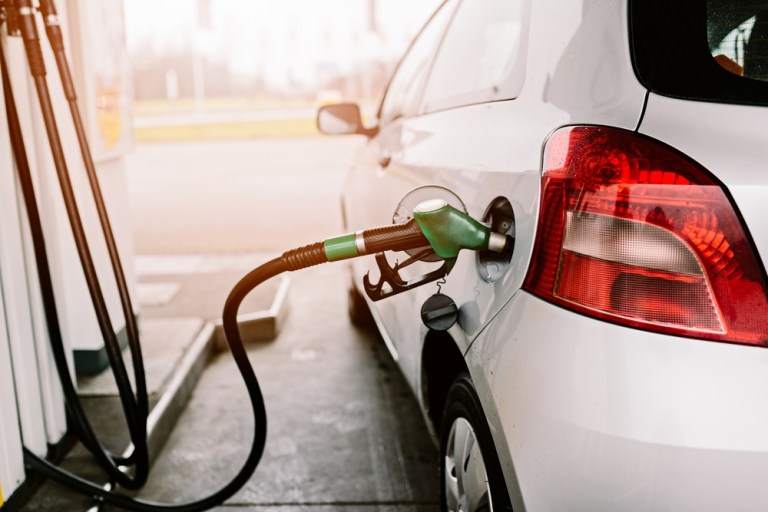
Let’s just come out and say it: When it comes to the wide range of commerce activities, unless you’re a teenager with a new driver’s license, putting gas into your vehicle is never fun.
The pumps are often grimy, card readers might not work, the air might be frigid or hot, and there may be an odor associated with rubber, petroleum or refuse. All you want to do is get the transaction over with, maybe grab some milk, chips or beer and get on with your day.
Fuel station executives surely know that. “Buying fuel is not a desirable purchase,” said Rod Tos, manager of customer payments and card services for energy provider Chevron. “It’s generally viewed as a negative experience. We recognize that.”
Gas station purchases are unlikely to ever achieve the level of joy brought about by the purchasing of clothes, furniture, toys or books, but the effort to make those transactions much more convenient — perhaps even pleasantly so — is moving along, as demonstrated by a recent product launch.
In-Dash Payments
Late last week (Aug. 16), Shell, General Motors and mobile payments provider P97 officially announced a service that enables drivers to find and pay for fuel via technology embedded in their vehicles’ dashboards. The technology makes use of the GM Marketplace platform, which also lets consumers order food and coffee, and make dinner reservations with participating firms, among other tasks.
“It’s like setting up an Uber account for the first time,” P97 CEO Don Frieden told PYMNTS. “You just have to set it up once.”
A driver running low on fuel could find one of 11,000 Shell stations in North America with the Marketplace platform, and start the payment process upon pulling up to a pump. The platform can also display discount offers. The in-dash system preauthorizes the payment and sends the driver a three-digit code, which the driver then enters into the pump’s keypad — the first time the driver must leave the vehicle. Following that, the pump is ready to go within seven seconds.
The driver then selects the fuel grade, pumps the gas and receives a receipt via phone, email or the Marketplace platform. In all, authentication takes about a third of the time of traditional fuel purchases, Frieden said.
In-dash fuel payments work for Chevrolet, Buick, GMC and Cadillac vehicles whose drivers have downloaded the Marketplace platform, which has been downloaded about three million times, with 2.5 million more downloads annually.
Other Activity
Shell is not the only fuel provider hoping to transform the gas run with mobile technology. Chevron, which operates approximately 8,000 gas stations in the U.S. under both the Chevron and Texaco banners, is one of several companies — including Exxon Mobile, Gulf and Cumberland Farms — that view smartphones as key to reinventing the consumer experience at the pump.
Consumers don’t expect fun, of course. “They want that transaction to be as speedy as possible, and they want it to be very secure,” Tos recently told PYMNTS. “They don’t want their credentials stolen by a fraudster.”
That said, only a small fraction of Chevron’s stations — approximately 300 nationwide — are currently equipped to accept mobile payments, and their overall use to pay for gas is relatively low. In fact, Chevron has seen just a 2 percent penetration rate for payments made using mobile apps at the pump, with patrons preferring to pay using credit or debit cards.
Millennial Promise
According to PYMNTS’ “Paying At The Pump Report: What Drives Mobile Adoption,” only 5.9 percent of 10,000 survey respondents consider having the ability to pay for gas to be “very” or “extremely” important. Respondents worry about the security of using mobile apps for gas purchases.
But convenience does count, at least with younger consumers. That same study found that 43 percent of high-income millennials are more likely to visit a gas station if its app offers them convenience, loyalty and savings. Those consumers are defined as having been born between 1978 and 1995, with annual incomes ranging from $75,000 to $150,000. And, contrary to some stereotypes, they do buy gas — 65 percent of them made at least one fuel purchase a week, compared with 58 percent of other respondents in the study who said the same.
Vital Incentives
The P97 project with Shell follows some of the logic outlined in that study — specifically, the importance of discount incentives. Drivers who are part of the Shell loyalty program receive discounts on gas, and some buyers “will change payment methods based on as little as five cents a gallon,” Frieden said.
And more convenience is on the horizon, as part of the emerging ecosystem of connected cars. In the future — Frieden said studies have shown that positive ROI is possible — the in-dash payment system could enable a driver pumping gas to order and pay for in-store goods, and have them delivered outside to the car.
No reasonable person would ever promise that gas runs will become a source of excitement, but there is reason to believe that fuel purchases will, at least, become more convenient.